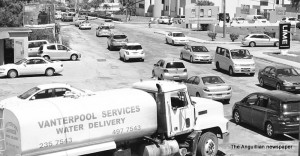A man called John Richardson, probably from The Valley, a so-called well-to-do gentleman, is said to have been the first owner of a vehicle in Anguilla. It is not certain what type of car he possessed, but it was rumoured that he was a fast driver – whatever was the state of the roads in his day, and they had to be in a most awful condition. One fearful woman is said to have reported that one day he accidentally ran his car into a house at East End. The next day, an aircraft flew over the area and, being afraid, she shouted: “The other day John Richardson run his car in the house, now look where he is: in God’s Almighty sky!” Perhaps all of this, or some of it, is just a fable, but true or false, it has a connecting story today.


The number of vehicles, of all types, imported into Anguilla, has grown from a trickle decades ago, to thousands today. As a consequence, the roads across the island are frequently inundated with rows of heavy traffic everywhere. This is especially the case during what may be described as the rush hours, and when the traffic lights switch to red, resulting in long lines of vehicles. Such is the snail pace of the traffic that, at times, a policeman is required to be at the “Mahogany Tree” crossroads, outside the premises of Mr. Albert Lake, to speed up the traffic in order to reduce the congestion when the stop lights appear to be working too slowly.
Except for a bicycle race, a police officer is rarely seen at the traffic lights on the busy Edwin Wallace Rey Drive, at George Hill, where motorists often queue up in large numbers, waiting for the green signal to appear on the stop lights. It is to the credit of motorists there, who wait patiently for the lights to change, and where speeding is a regular habit, that there are not many more accidents there. Farther down the road, however, traffic officers, with their surveillance vehicles parked inside small off-the-road gaps, stealthily wait to ‘bust’ and charge speeding drivers. This is also a practice seen on similar long stretches of roads, in other parts of the island, where motorists drive recklessly and where there are no stop lights.
Any discerning person, whether a resident or visitor, is well aware of the growing influx of vehicles into Anguilla – and of course the Inland Revenue Department, and the Government, of necessity welcome the import duty and licences coming into the Treasury. Private persons, families and business places, own several vehicles and car rental companies many more. Vehicle repair garages are usually filled and overflowing; agencies and other dealers have many vehicles for sale; and while more are being brought in regularly, hundreds of wrecks are everywhere, some creating eyesores in what is a tourism upmarket destination.
It is amazing, perhaps, in such a tiny island, as Anguilla, that there are so many vehicles on our roads. At the same time, however, it is a tribute to the modern day life, ambition, pride and industry of our people, and the independent quest of individuals, to own their own form of transport. Nothing can be amiss about this in a growing affluent island nation.
There are, however, various requirements to pay heed to. Our motorists must drive with due care and attention on our now vastly-improved roads; respect their fellow motorists as well as pedestrians – especially children – and avoid cruelty to animals crossing the roads; ensure that their vehicles are road-worthy, in the best of repair; and that the required licences and insurance coverage are up-to-date. In this manner, much will be achieved in preventing accidents resulting in injury or death to persons; proper compensation; damage to vehicles necessitating exorbitant repair costs; and prosecution of offending motorists.
There are also requirements to be met by the Police and the Government. Both must ensure that there are always suitable and fair laws and regulations for traffic control and safety on the roads of Anguilla. Insurance companies must ensure that the policies they sell to motorists offer all of the necessary safeguards; are always kept current and are available at affordable costs. The Government, which collects hefty import duties and licence fees, must, in term, ensure that there is a network of well-maintained roads; and that, where necessary and possible, new roads or highways are provided. The 2015 Manifesto of the governing Anguilla United Front Government speaks about road development in The Valley area – and providing access roads to housing lots. Given the increasing traffic on the island, there is in fact a need for additional public roads outside The Valley area to better facilitate the flow of traffic to various parts of Anguilla, and to open new areas of development.
Attention to some of the above matters, and other initiatives, will have the welcome effect of improving roadways and regulating traffic, including relieving traffic jams on the roads of Anguilla.








